GeForce RTX 3090 is the most powerful graphics card in the RTX 30 series and also the most powerful consumer graphics card in the world right now. It is titled as BFG by Nvidia, which means Big Ferocious GPU, because of its big size and tremendous performance. The card is insanely powerful, and it even leaves the TITAN RTX in the dust. It is also quite expensive compared to many other cards out there. The card is huge and consumes three slots on the motherboard. So, if you want to know how RTX 3090 compares against the TITAN RTX and its younger brother RTX 3080, then you will find out below.
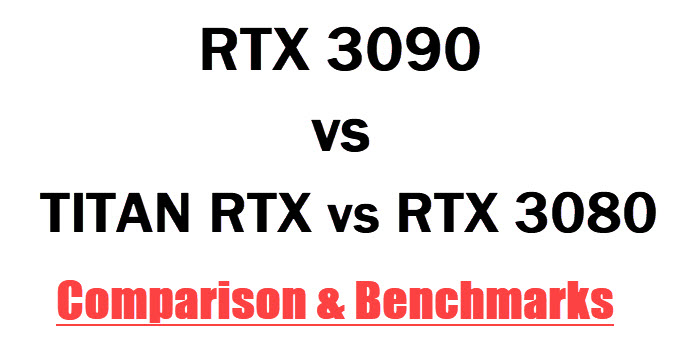
RTX 3090 vs TITAN RTX vs RTX 3080
Below is the comparison between RTX 3090, TITAN RTX, and RTX 3080 graphics cards based on their specifications, performance, pricing, power consumption, and features.
GPU Architecture
RTX 3090 and RTX 3080 are GeForce RTX 30 series cards built on the latest Ampere GPU architecture on Samsung’s 8nm manufacturing process. They both use the TU102 GPU chip, but the RTX 3080 is a cut-down variant of that chip and comes with a lesser number of CUDA Cores. On the other hand, TITAN RTX is built on the Turing GPU architecture on the 12nm TSMC fabrication process and uses TU102 GPU. RTX 3090 comes with a whopping 10496 CUDA Cores, 82 RT Cores, and 328 Tensor Cores. Its younger brother RTX 3080 comes with 8704 CUDA Cores, 68 RT Cores, and 272 Tensor Cores. On the other hand, TITAN RTX comes with 4608 CUDA Cores, 72 RT Cores, and 576 Tensor Cores. The newer Ampere architecture delivers significant performance increase over the Turing architecture and offers double FP32 performance, and CUDA Cores count.
| RTX 3080 | TITAN RTX | RTX 3090 | |
| GPU Chip | GA102 | TU102 | GA102 |
| GPU Architecture | Ampere | Turing | Ampere |
| Fabrication Process | 8nm | 12nm | 8nm |
| CUDA Cores | 8704 | 4608 | 10496 |
| RT Cores | 68 | 72 | 82 |
| Tensor Cores | 272 | 576 | 328 |
Video Memory [VRAM]
RTX 3090 and 3080 come with GDDR6X memory, which is currently the fastest graphics memory, and it runs at a speed of 19Gbps on RTX 3080 and at 19.5 Gbps on RTX 3090. The memory on these cards differs in bus width, capacity, and bandwidth. RTX 3090 comes with 24GB GDDR6X memory having a bus width of 384-bit and offers a bandwidth of 936 GB/s, while the RTX 3080 has 10GB GDDR6X memory having an interface of 320-bit and offers a comparatively lesser bandwidth at 760 GB/s. On the other hand, TITAN RTX comes with 24GB GDDR6 memory having an interface of 384-bit. It runs on a lower speed of 14 Gbps and provides a memory bandwidth of 672 GB/s, which is the lowest of all three cards here.
| RTX 3080 | TITAN RTX | RTX 3090 | |
| Memory Size | 10 GB GDDR6X | 24 GB GDDR6 | 24 GB GDDR6X |
| Memory Interface | 320-bit | 384-bit | 384-bit |
| Memory Speed | 19 Gbps | 14 Gbps | 19.5 Gbps |
| Memory Bandwidth | 760 GB/s | 672 GB/s | 936 GB/s |
Features
All these cards support major APIs like DirectX 12 Ultimate, OpenGL 4.6, and Vulkan 1.2. Moreover, all these cards support Real-Time Ray Tracing and DLSS (Deep Learning Super Sampling), but the RTX 3090 and RTX 3080 come with 2nd generation RT cores and 3rd generation Tensor cores that include more features and provide better performance compared to the 1st generation RT Cores and 2nd generation Tensor Cores present in the TITAN RTX. Another major upgrade in the RTX 3090 and RTX 3080 cards is that they support the latest PCIe 4.0 interface that provides 2X bandwidth over the older PCIe 3.0 standard supported by the TITAN RTX. Some other new features introduced with the RTX 30 series card include Nvidia Reflex (to reduce game latency) and RTX IO that helps in reducing game loading time by using the graphics card video memory for game decompression and storing textures.
RTX 3090 and 3080 also support the latest HDMI 2.1 display interface that can deliver much higher resolution and refresh rates on a single cable. It can support 8K@60Hz, 4K@120Hz, and up to 10K resolutions with the support for Dynamic HDR. The maximum bandwidth associated with HDMI 2.1 is 48 Gbps, which is tremendous. RTX 3080 does not support SLI or NVLink multi GPU interface while RTX 3090 and TITAN RTX do by using the NVIDIA RTX NVLink Bridge. If we talk about productivity, then RTX 3090 and RTX 3080 comes with 5th generation Nvidia Decoder and natively supports AV1, which is a royalty-free, highly efficient codec and can reduce the bandwidth of high stream resolution video by up to 50% compared to H.264 and can make 4K and 8K streaming feasible for someone with an average or mediocre internet connection.
| RTX 3080 | TITAN RTX | RTX 3090 | |
| Bus Interface | PCI Express 4.0 | PCI Express 3.0 | PCI Express 4.0 |
| DirectX | 12 Ultimate | 12 Ultimate | 12 Ultimate |
| OpenGL | 4.6 | 4.6 | 4.6 |
| Vulkan | 1.2 | 1.2 | 1.2 |
| SLI | No | Yes – With NVIDIA RTX NVLink Bridge | Yes – With NVIDIA RTX NVLink Bridge |
| VR Ready | Yes | Yes | Yes |
| NVIDIA Encoder (NVENC) | Gen 7 | Gen 7 | Gen 7 |
| NVIDIA Decoder (NVDEC) | Gen 5 (with AV1 Decode Support) | Gen 4 | Gen 5 (with AV1 Decode Support) |
| G-Sync | Yes | Yes | Yes |
| HDMI 2.1 | Yes | No | Yes |
Gaming Performance
Here are the gaming benchmarks of these cards at 1440p and 4K resolution.
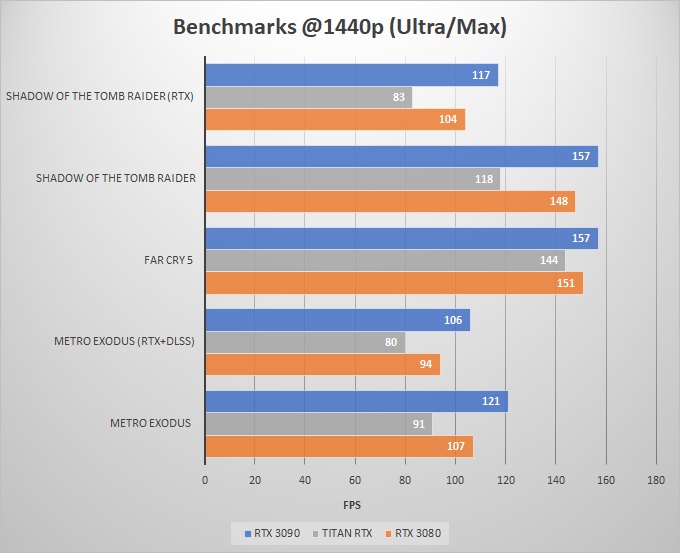
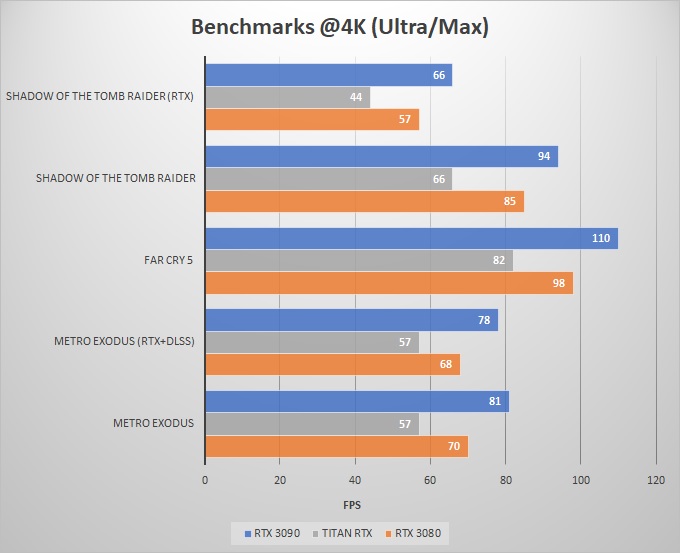
From the above gaming benchmarks, you can see that RTX 3090 is the most powerful of all three graphics cards. It is around 30% faster than TITAN RTX on average and about 10% to 15% faster than RTX 3080.
Power Consumption
The power consumption of RTX 3090 and RTX 3080 is relatively higher at 350W and 320W, respectively. However, they have high efficiency and offer up to 1.9X performance per watt improvement over the older architectures that include Turing and Pascal. The PSU requirement for both these cards is 750W. On the other hand, TITAN RTX has a power consumption figure of 280W and requires a 650W PSU for its working.
| RTX 3080 | TITAN RTX | RTX 3090 | |
| Power Consumption | 320W | 280W | 350W |
| Recommended PSU | 750W | 650W | 750W |
Pricing & Availability
The most expensive card here is the TITAN RTX which costs $2499 at the time of launch, but nowadays, you can get it a little cheaper. The MSRP of the RTX 3090 is $1499, and the least expensive card here is the RTX 3080 with a base MSRP of $699. RTX 3090 and RTX 3080 are also available in custom models from various AIBs, while TITAN RTX is only available as Founders Edition, which is the original reference card from the Nvidia. You can check the latest prices of these cards from the links below.
Check RTX 3090 Price on Amazon
Check RTX 3080 Price on Amazon
Check TITAN RTX Price on Amazon
| RTX 3080 | TITAN RTX | RTX 3090 | |
| MSRP (at launch) |
$699 | $2499 | $1499 |
RTX 3090 vs TITAN RTX vs RTX 3080 Specifications
| RTX 3080 | TITAN RTX | RTX 3090 | |
| GPU Chip | GA102 | TU102 | GA102 |
| GPU Architecture | Ampere | Turing | Ampere |
| Fabrication Process | 8nm | 12nm | 8nm |
| CUDA Cores | 8704 | 4608 | 10496 |
| RT Cores | 68 | 72 | 82 |
| Tensor Cores | 272 | 576 | 328 |
| Memory Size | 10 GB GDDR6X | 24 GB GDDR6 | 24 GB GDDR6X |
| Memory Interface | 320-bit | 384-bit | 384-bit |
| Memory Speed | 19 Gbps | 14 Gbps | 19.5 Gbps |
| Memory Bandwidth | 760 GB/s | 672 GB/s | 936 GB/s |
| Bus Interface | PCI Express 4.0 | PCI Express 3.0 | PCI Express 4.0 |
| DirectX | 12 Ultimate | 12 Ultimate | 12 Ultimate |
| OpenGL | 4.6 | 4.6 | 4.6 |
| Vulkan | 1.2 | 1.2 | 1.2 |
| SLI | No | Yes – With NVIDIA RTX NVLink Bridge | Yes – With NVIDIA RTX NVLink Bridge |
| VR Ready | Yes | Yes | Yes |
| G-Sync | Yes | Yes | Yes |
| Power Consumption | 320W | 280W | 350W |
| Recommended PSU | 750W | 650W | 750W |
See also:
Final Thoughts
RTX 3090 is a beast and is currently the most powerful graphics card in the consumer segment. If you are getting it for gaming purposes, then it does not make any sense as its performance over the RTX 3080 is not that much greater, and also the 24GB VRAM and extra CUDA Cores do not come into much use. The primary market of this card is for workstations and for enthusiasts and professionals who work with Davinci Resolve, Blender, CAD, CAM, Animation, and professional software that require a ton of GPU power. RTX 3090 has made the TITAN RTX completely obsolete because RTX 3090 offers significantly greater performance at a lesser price. On the other hand, RTX 3080 is still the best gaming card in the market right now even though it is less powerful than RTX 3090, because of its excellent price-to-performance ratio. If you have anything to say then please leave a comment below.
(*This post may contain affiliate links, which means I may receive a small commission if you choose to purchase through the links I provide (at no extra cost to you). Thank you for supporting the work I put into this site!)
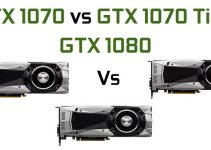
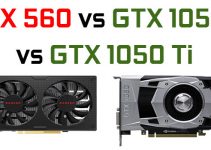
![Best RTX 3060 Cards for 1080p & 1440p Gaming [Custom AIB Models] Best RTX 3060 Cards for 1080p & 1440p Gaming [Custom AIB Models]](https://graphicscardhub.com/wp-content/uploads/2021/03/MSI-GeForce-RTX-3060-GAMING-X-TRIO-12G-211x150.jpg)